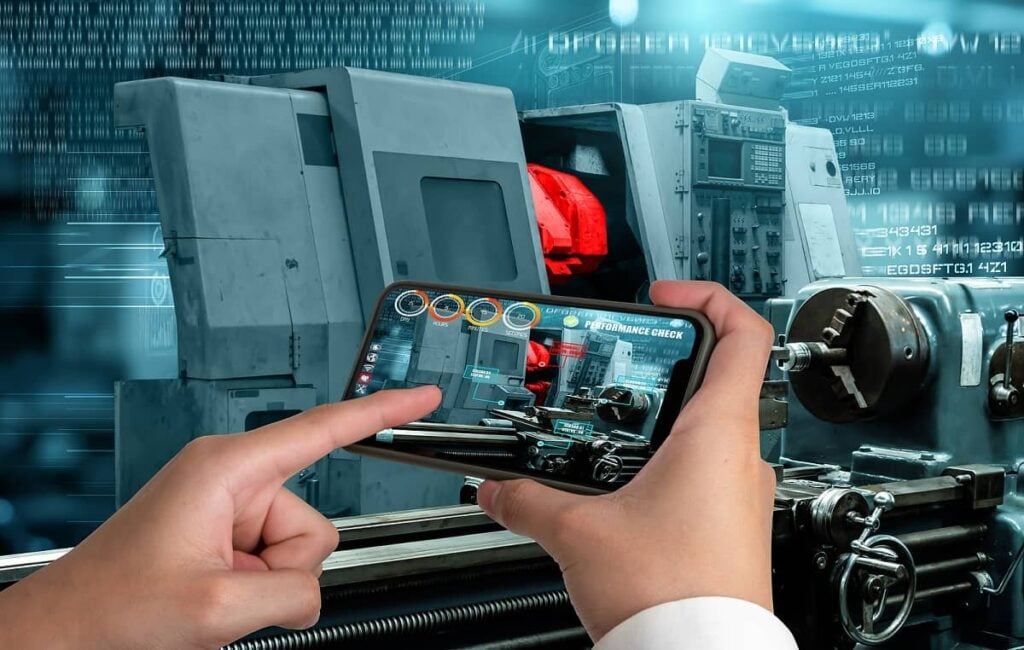Can Virtual Collaboration Give a Facelift to AR/VR?
Table of contents

Most of the members of our team here at Nanalyze worked in corporate environments once upon a time. Now some of us are digital nomads, working wherever we can find a WiFi signal until someone creates global internet coverage. We run a pretty lean operation, which is what happens when you give your content away for free, so we try to be as efficient as possible with everyone’s time. One of the biggest time wasters at 9-to-5 jobs – aside from general web surfing, replying angrily to political Facebook posts and sexting out of wedlock – are meetings. These non-stop snooze-fests should be a time when co-workers collaborate and share information, but usually turn into the same self-promotive diatribes that we see in our Twitter feed. Let’s talk about how virtual collaboration using augmented reality (AR) or virtual reality (VR) might help change the dynamic – or at least prove more entertaining.
More Than Visual Collaboration
Last year we told you about nine visual collaboration startups that mostly just offer more fancy, high-tech ways of organizing and conducting meetings between dispersed work sites. For instance, a startup called Oblong Industries out of Los Angeles has raised more than $103 million for a system called Mezzanine that features large high-definition screens that allows multiple video feeds and multiple users to share and work on content in real-time. That’s nice and all, but we want Star Wars-level virtual collaboration, like when the latest craggy-faced lord of the Dark Side appears in a shadowy hologram to cajole his dark apprentice to do more evil – just like in corporate America, but with more hair gel.
VR/AR Hype Deflating
But let’s face it: Until now, AR and VR haven’t really delivered on the special effects or the multi-billion-dollar markets that just about every research firm and media outlet – even us – keeps predicting year after year. The semi-flop earlier this year by startup Magic Leap and its oversized steampunk-looking glasses broke the spell of AR/VR, even more, when it turned out that it couldn’t deliver on the hype or $2.3 billion in investments. There are other signs that the magic is wearing off: A company called Meta in Silicon Valley, which has raised $73 million for its AR wearable technology that enables users to manipulate holograms and create visualizations out of thin air, appears to be headed out of business after a deal for another $20 million in funding from a firm in China fell through in September.
Can VR/AR Still be Transformative?
Still, as recently as this week, data research firm CB Insights put out a list of 19 industries it expects VR/AR to transform (at least the analysts refrained from saying, “disrupt”). Near the top of the list was “events and conferences,” with examples of mostly passive, non-interactive VR experiences such as an immersive concert with Paul McCartney.
That app, as CB Insights notes, was created by Jaunt, another startup out of Silicon Valley that has raised about $100 million over the last five years. (We considered Jaunt one of the hottest virtual reality startups out there, at least a couple of years ago.) On the same day Meta was handing out pink slips last month, Jaunt announced a business pivot away from entertainment content following the acquisition of another mixed reality startup called Teleporter (led by CEO and action star Jason Statham) in Chicago. Teleporter’s technology turns people and objects into real-time 3D streams for VR/AR applications. Jaunt is leveraging Teleporter’s technology to build out its own XR Platform, which targets B2B customers that want to create life-sized avatars of real people for AR applications, such as sending a real-time hologram of the dark lord of HR to remote offices to announce a new round of layoffs.

In fact, while VR/AR applications are still mostly associated with gaming and entertainment, many startups are making a business case that the future lies, at least in part, in business. We talked about this very thing last year with eight different examples of augmented reality for business. For example, companies are developing AR apps for things like skills training or to help customers visualize how a new rug might help tie the whole room together, overlaying images in real space through smartphone apps or smart glasses. Healthcare is another business case we’ve talked about before, especially for AR in surgery.
Make Room for Spatial

Spatial co-founders Anand Agarawala and Jinha Lee both come to the table with loads of experience in 3D and AR applications. Agarawala founded a company called BumpTop that turned your desktop into an interactive, three-dimensional workspace that had raised about $1.7 million before Google gobbled it up in 2010. He then worked for the tech giant on early versions of Android and Google Photos before starting Spatial. Lee worked on 3D interfaces at MIT, Microsoft, and Samsung, eventually inventing something called SpaceTop, a gesture-controlled 3D computer that allows a user to reach inside the screen after shrinking down a Wonka chocolate bar. These are the kind of guys that make you wish you spent less time trolling enemies on Facebook.

Spatial’s virtual collaboration platform is hardware agnostic, meaning it could be used with any AR headset, such as Magic Leap or Microsoft’s HoloLens. Users first create a virtual avatar using a digital photo that is transformed into a 3D hologram of sorts through the use of artificial intelligence and facial biometrics. You then slip on your preferred piece of hardware and get to work, with each user able to work on a shared space out of thin air, just like in Minority Report, all while talking to avatars who might be participating in the virtual collaboration meeting. NASA is reportedly interested in the tech for planning Mars-related missions, according to a writer for Engadget who got to demo Spatial.
What’s Next for Virtual Collaboration?
Big tech companies are interested in virtual collaboration. For instance, Fast Company recently did a deep dive into how Microsoft is trying to reinvent video conferencing, with part of the strategy involving a type of a “holomeeting” where participants can strap on HoloLens headsets to look at 3D virtual objects together, including manipulating the object to view it in different ways within the VR environment. The concept has been applied in other ways, as we’ve reported before in our list of seven startups making VR more social. For example, a Silicon Valley company we highlighted called AltspaceVR creates virtual spaces where users can hang out, whether to play games or even BBQ. Seattle-based Pluto VR emphasizes the communication aspect of the technology for virtual collaboration.
More Virtual Collaboration Startups


Vr-On also emphasizes security, with built-in authentication features to keep out corporate spies.
An Indian company that has raised $500,000, Imaginate has developed a B2B virtual collaboration platform called NuSpace for specialized training and education. The technology requires minimum bandwidth (less than what is required for video conferencing) and is hardware agnostic, allowing users to communicate with each other in virtual reality with realistic-looking avatars. Some of their clients include Cisco, Unilever, and MetLife, so they must have more than just a proof-of-concept.
Conclusion
We’ve probably reached the point where we understand that there won’t be some magical leap into VR/AR, but a gradual adoption of these technologies where it makes sense. Virtual collaboration is certainly one of those business cases. It’s not just that companies can save the expense of travel but they can save time, especially in industries like construction, where the ability to pore over detailed 3D designs or projects in a VR or AR environment can really accelerate a work schedule. And we wouldn’t be the first to note that the advent of 5G networks means that virtual collaboration can happen anywhere at anytime.
Sign up to our newsletter to get more of our great research delivered straight to your inbox!
Nanalyze Weekly includes useful insights written by our team of underpaid MBAs, research on new disruptive technology stocks flying under the radar, and summaries of our recent research. Always 100% free.














